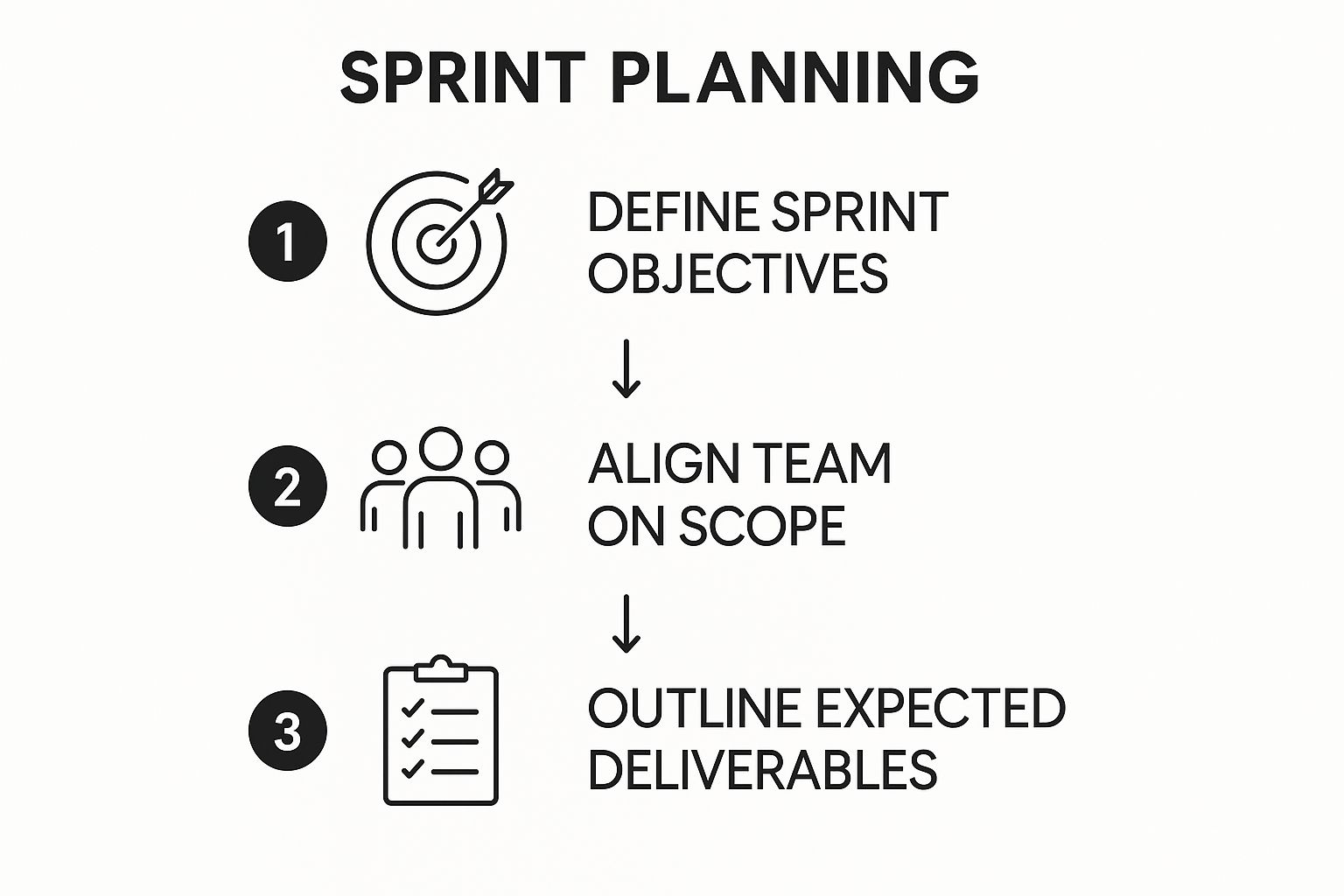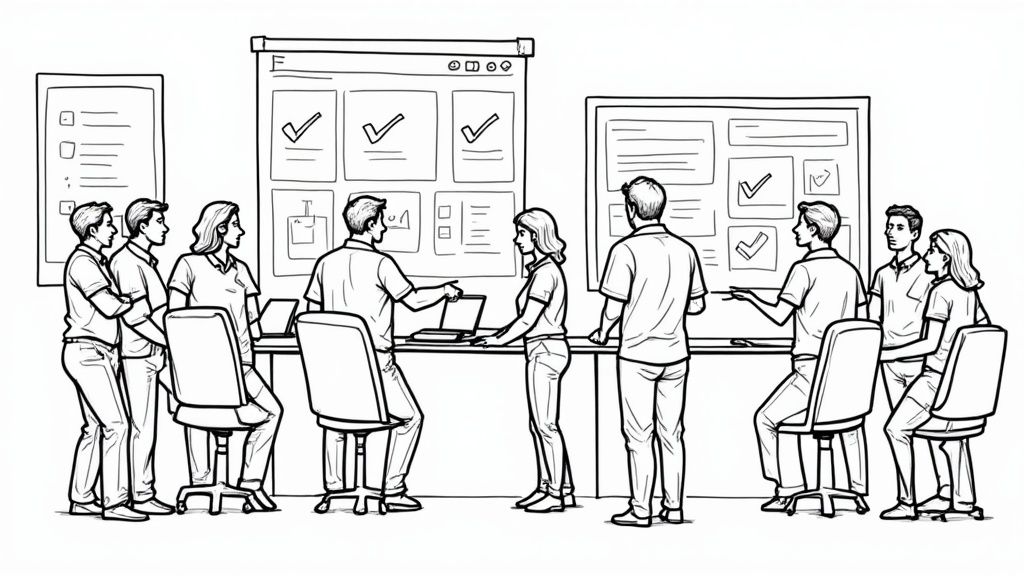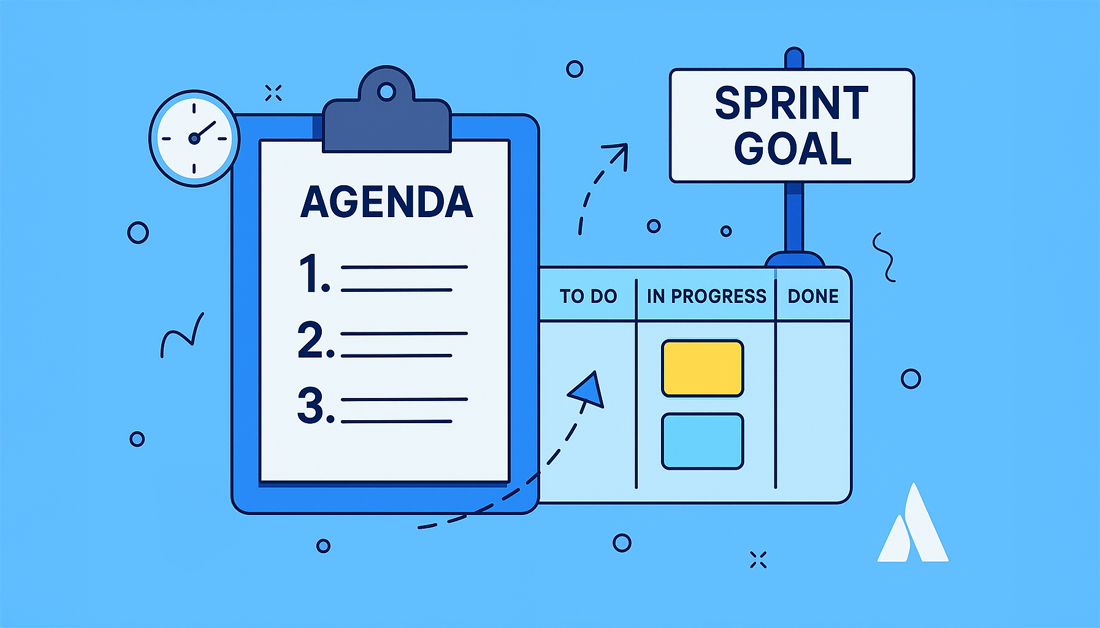Understanding What Makes Sprint Planning Actually Work
Effective sprint planning is the cornerstone of successful sprints. It’s not simply about checking off items on a sprint planning meeting agenda template; it’s about building a shared understanding and commitment within the team. This involves open communication, clear objectives, and a realistic assessment of what can be accomplished. Doing so lays the groundwork for a productive and fulfilling sprint, impacting not only the project’s results but also the team’s overall morale.

This infographic illustrates the initial steps in sprint planning: defining sprint objectives, aligning the team on the scope, and outlining the anticipated deliverables. The sequential nature of the process emphasizes how important it is to establish clear objectives before determining the scope and, ultimately, outlining the deliverables. This logical progression ensures the entire team begins the sprint with a unified vision. You might also find this helpful: Your ultimate guide to sprint planning.
The Importance of a Shared Vision
Uniting the team around a common goal is paramount. When everyone understands the reason behind the sprint, their engagement and motivation increase. This shared understanding minimizes potential confusion and keeps the team laser-focused on the overarching objective. Sprint planning becomes a collaborative endeavor, not just a list of assigned tasks.
Realistic Planning and Team Capacity
A crucial element of effective sprint planning is realistic planning. This requires an honest evaluation of the team’s capacity, leading to a manageable workload. Overloading the sprint backlog often leads to missed deadlines and can negatively impact team morale.
For instance, if a team usually completes 10 story points per sprint, trying to cram in 20 story points will likely result in unfinished work and frustration. Furthermore, sprint planning meetings are vital for defining clear sprint goals. According to the Scrum Alliance, 86% of Scrum teams hold these meetings, underscoring their significance in Agile methodologies. More detailed statistics can be found here.
Adaptability and Flexibility
While a solid plan is essential, adaptability is equally important. Unexpected roadblocks and issues inevitably arise during a sprint. Teams must be flexible and willing to adjust the plan accordingly. This adaptability helps keep the sprint on track, even when facing unanticipated difficulties. You can learn more about adapting sprint plans here.
Building Your Sprint Planning Meeting Agenda Template
Stop constantly improvising your sprint planning meetings. High-performing teams rely on structured agendas to make the most of their time and ensure valuable output. This shifts the dynamic from scattered brainstorming to focused, productive work sessions. By observing successful teams, we can identify the key agenda items, optimal timeframes, and techniques for seamless transitions. This comprehensive approach helps avoid “analysis paralysis” and keeps the team on track.
Essential Components of a Sprint Planning Meeting Agenda
A well-designed sprint planning meeting agenda template serves as a roadmap, guiding the team through each step of the planning process. This guarantees efficient coverage of all essential topics, while allowing flexibility based on team size and sprint duration.
-
Sprint Goal: Start by clearly defining the sprint goal. This overarching objective unites the team and provides a shared focus.
-
Product Backlog Refinement: Review and refine the product backlog, ensuring user stories are clearly defined, estimated, and prioritized. This preparation is crucial for selecting the right items for the sprint backlog.
-
Sprint Backlog Selection: Collaboratively choose product backlog items for the current sprint, carefully considering team capacity and alignment with the sprint goal.
-
Task Breakdown: Break down selected user stories into actionable tasks, assigning ownership and estimating the effort required for each. This clarifies individual responsibilities and promotes accountability.
-
Risk Assessment: Identify potential roadblocks and develop strategies to mitigate them. Proactive risk management helps minimize disruptions and keeps the sprint on schedule.
-
Review and Confirmation: Review the finalized sprint backlog and confirm the team’s commitment. This ensures everyone is aligned and ready to begin the sprint.
Adapting Your Sprint Planning Agenda Template
Adaptability is crucial for an effective sprint planning meeting agenda template. The template should be tailored to the specific needs of both the team and the project. You might be interested in: How to master sprint planning tools.
For example, a small team might combine Product Backlog Refinement and Sprint Backlog Selection into one session. Conversely, larger teams or complex projects might require more time dedicated to Risk Assessment and dependency planning. The time allocated to each item can also be adjusted based on the sprint length. A shorter sprint may need less planning time compared to a longer one.
Optimizing Time Allocation and Transitions
Just as selecting the right items for your sprint is important, so is allocating the right amount of time. Much like a chef carefully measures ingredients, the Scrum Master needs to carefully allocate time within the sprint planning meeting. For a two-week sprint, a maximum of four hours for the entire meeting is a good target.
The following table offers a sample breakdown of a potential sprint planning agenda:
Sprint Planning Agenda Template Breakdown
Detailed agenda structure with time allocations and key objectives for each phase
| Agenda Item | Duration | Key Objectives | Participants |
|---|---|---|---|
| Sprint Goal | 30 minutes | Define a clear, concise, and measurable sprint goal | Entire Team |
| Backlog Refinement | 1 hour | Review, estimate, and prioritize user stories | Product Owner, Development Team |
| Sprint Backlog Selection | 1 hour | Choose user stories for the sprint based on capacity and sprint goal | Entire Team |
| Task Breakdown | 1 hour | Decompose user stories into actionable tasks with assigned owners and effort estimations | Development Team |
| Risk Assessment | 30 minutes | Identify and discuss potential roadblocks and mitigation strategies | Entire Team |
This table illustrates a potential time distribution, highlighting the key objectives and participants for each agenda item. Remember, these durations are examples and can be adjusted to fit your team’s needs.
Smooth transitions between agenda items are also essential for maintaining momentum. Clearly signal the end of one section and the beginning of the next. Summarize key decisions and concisely introduce the following topic. For instance, after defining the sprint goal, the Scrum Master could say, “Now that we’ve established our sprint goal, let’s move on to refining the product backlog and identifying the user stories that will contribute to achieving it.” This approach promotes focus and productivity.

Sprint Planning Success Beyond Software Development
Traditionally, sprint planning has been a cornerstone of software development. It provides a framework for Agile teams to organize their work and achieve iterative goals. However, this structured approach offers benefits beyond the tech world. Various industries, from marketing and sales to operations and creative projects, are increasingly adopting this methodology. This expansion demonstrates the adaptable nature of the sprint planning meeting agenda template.
Adapting Sprint Planning to Different Industries
Marketing teams, for instance, can use sprint planning to coordinate multi-channel campaigns. Breaking down complex projects into smaller, manageable sprints ensures consistent messaging across various platforms and allows adaptation to changing market dynamics.
Sales teams can utilize sprints to align on quarterly targets, focusing their efforts on specific customer segments or product lines. Even operations teams are finding value in sprint planning for process improvements, identifying bottlenecks, and implementing solutions iteratively.
This broader adoption highlights the versatility of sprint planning. A significant 49% of marketers report using Sprint/Iteration planning, indicating a growing trend of embracing Agile practices outside software development. Explore this topic further here.

Tailoring the Approach
While core principles remain consistent, applying sprint planning to non-software contexts requires modifications. Terminology adjustments are often necessary. Instead of “user stories,” marketing teams might use “campaign objectives.” This shift in language ensures clarity and buy-in from team members unfamiliar with traditional Agile jargon.
Industry-specific challenges also need addressing. Creative projects often require more flexibility than software development. Adapting the sprint planning meeting agenda template to accommodate iterative feedback and evolving creative vision is essential. Highly regulated industries, like healthcare or finance, may need to incorporate compliance requirements into their sprint planning process.
Overcoming Resistance and Building Buy-in
Introducing Agile methodologies to non-technical departments can sometimes meet resistance. Team members accustomed to waterfall approaches may hesitate to embrace the iterative nature of sprint planning.
To overcome this, clearly communicate the benefits of sprint planning. Emphasize improved collaboration, increased transparency, and faster delivery of results. Practical training and ongoing support can help team members adapt to the new framework and effectively use a sprint planning meeting agenda template.
Highlighting success stories from other departments or industries can also build confidence and demonstrate the value of sprint planning. Showcasing positive outcomes achieved by similar teams using these methodologies fosters a culture of experimentation and continuous improvement. Successful sprint planning implementation depends on clear communication, practical training, and a commitment to adapting the framework to each team’s and industry’s unique needs.
Setting Your Team Up For Sprint Planning Success
The key to a productive sprint planning meeting isn’t just having a template; it’s the preparation beforehand. The difference between a focused, efficient planning session and a frustrating time-waster often boils down to the pre-meeting work. High-performing teams recognize this, dedicating time to crucial preparatory activities. This proactive approach paves the way for a sprint where the team starts strong and maintains its momentum.
Essential Homework for the Team
Just as a successful rocket launch requires meticulous pre-flight checks, a successful sprint requires careful preparation. Each team member plays a vital role. The Product Owner, for example, should concentrate on refining the Product Backlog. This involves ensuring user stories are clearly defined, estimated, and prioritized. This groundwork enables a more efficient selection of items for the Sprint Backlog during the planning meeting. Gathering early feedback from stakeholders also ensures their perspectives are integrated, minimizing potential obstacles later. You might find this interesting: How to master NASA-style sprint planning.
The Scrum Master contributes by facilitating capacity planning. Understanding the team’s bandwidth for the upcoming sprint allows for realistic goal setting and prevents overcommitment. This involves accounting for factors like planned time off or other project commitments. The development team also benefits from reviewing the refined Product Backlog in advance. Early familiarity with potential sprint items allows developers to identify dependencies or potential roadblocks, enabling proactive solutions during the planning meeting.
Streamlining the Preparation Process
Think of sprint planning like preparing for a road trip. You wouldn’t just hop in the car and start driving without a destination or a map. Similarly, successful sprint planning requires a roadmap and a clear destination. Techniques like backlog grooming, user story refinement, and dependency mapping are valuable tools. Backlog grooming, like tidying your car before a road trip, removes unnecessary items and ensures you’re only packing essentials. This results in a clear, prioritized list ready for discussion.
Avoiding Common Pitfalls
Many teams, despite their best efforts, encounter preventable mistakes during sprint planning. Unclear requirements, absent stakeholders, and unrealistic expectations are common issues that can derail even the best-laid plans. However, these pitfalls can be avoided with adequate preparation. For instance, ensuring acceptance criteria are clearly defined beforehand prevents ambiguity and guarantees the team understands the definition of “done.” This clarity helps prevent misunderstandings and rework later.
By prioritizing preparation, teams can bypass common obstacles and greatly improve the efficiency of their sprint planning sessions. This investment translates to improved focus, boosted productivity, and ultimately, a more successful sprint.
Facilitating Sprint Planning Meetings That Actually Work

A well-structured sprint planning meeting agenda template is essential, but it’s only the first step. The real key to success lies in how you facilitate the meeting. Effective facilitation can transform a routine planning session into a dynamic and productive experience. This involves fostering open communication, encouraging active participation, and guiding the team towards concrete outcomes that everyone understands and supports. Understanding team dynamics, especially in distributed teams, is crucial. For insights on leading remote teams, check out this resource on managing remote sales teams.
Mastering the Art of Facilitation
A skilled facilitator guides the team through the sprint planning process, making sure everyone has a chance to contribute. This involves actively encouraging participation, particularly from quieter team members, and effectively managing different personalities.
Several techniques can help achieve this. Round-robin discussions, for example, can ensure everyone shares their perspective. Brainstorming sessions can unlock creative solutions and build team consensus. It’s also important to encourage constructive disagreement. A good facilitator creates a psychologically safe environment where team members feel comfortable voicing their opinions, even if they differ from the majority view.
Asking Powerful Questions and Reaching Consensus
Effective facilitation goes beyond simply managing the meeting’s agenda. It involves asking insightful questions that uncover hidden assumptions and challenge the team’s thinking.
Consider questions like, “What dependencies do we need to consider?” or “What are the potential risks associated with this user story?” These questions help the team delve deeper into the planning process, proactively identifying potential problems before they escalate into major roadblocks. Efficiently reaching consensus is equally important. This might involve voting, dot-voting, or simply facilitating open discussion until the team arrives at a shared decision.
Maintaining Momentum and Engaging the Team
Maintaining momentum is vital, especially when discussions get bogged down in technical details. A facilitator can intervene by summarizing key points, redirecting the conversation when necessary, or suggesting short breaks to clear the air. This keeps the meeting focused and productive. For further guidance, explore these tips on How to master best practices in sprint planning.
Engaging the team throughout the process is crucial for maintaining energy and focus. Visual aids can be helpful, as can collaborative tools and interactive techniques. Using a whiteboard to visualize the sprint backlog, for example, or leveraging online collaboration tools like Miro for real-time brainstorming can significantly boost engagement.
Handling Common Sprint Planning Challenges
Even with excellent facilitation, challenges can still emerge during sprint planning meetings. Scope creep, unrealistic stakeholder expectations, and time constraints are common hurdles. A skilled facilitator can help the team navigate these challenges by negotiating scope with stakeholders, prioritizing tasks based on value and feasibility, and managing time effectively to ensure all key items are addressed within the allocated timeframe. Having proactive strategies to address these common issues is essential for keeping the sprint on track and achieving the sprint goals.
Avoiding Sprint Planning Traps That Sabotage Success
Even experienced teams sometimes stumble into sprint planning pitfalls. These mistakes can seriously slow down progress and ultimately prevent a sprint from succeeding. By learning from other teams’ experiences and analyzing case studies, we can spot common sprint planning mistakes and come up with solutions. Being proactive helps prevent problems like chronic underestimation, over-planning, and poor communication before they have a chance to derail your sprint.
Recognizing the Warning Signs
Over-planning is a frequent trap. This is when teams get bogged down in the tiny details of every single task. It can lead to analysis paralysis, eating up valuable time and blocking progress. Underestimation is another common problem. Teams might not accurately estimate the effort needed for tasks. This might happen because of unclear acceptance criteria, a lack of past data to draw on, or just being too optimistic. The result is often unmet sprint goals and missed deadlines. For more insights on sprint reviews, check out this helpful article: How to master retrospectives in sprints.
Stakeholder communication can also be a major challenge. If stakeholders aren’t involved enough in planning, or aren’t kept up to speed, their expectations might be different from what the team delivers. This can lead to dissatisfaction and having to redo work. Similarly, if there isn’t enough follow-up after the sprint planning meeting, it can create ambiguity and confusion, impacting the team’s commitment and slowing down progress.
Addressing Cultural and Organizational Challenges
Beyond the logistical issues, cultural and organizational challenges can also create problems for sprint planning. These can include competing priorities within the organization, a lack of buy-in from team members, and resistance to change. For effective sprint planning, it’s crucial to build a culture of shared commitment and ownership. This involves empowering team members, setting clear roles and responsibilities, and encouraging open communication. Good sprint planning meetings need strong business negotiation techniques.
Overcoming Common Obstacles
A few recurring obstacles can get in the way of successful sprint planning. Unclear acceptance criteria can create confusion about when a task is finished, which often leads to delays and rework. Also, if dependencies between tasks aren’t identified, it can disrupt the workflow and create bottlenecks. Perhaps the biggest challenge is unrealistic commitments: teams commit to more work than they can actually deliver during the sprint. This can be due to pressure to deliver quickly or a lack of accurate capacity planning.
The table below illustrates some common sprint planning pitfalls, their impact, and how to avoid or fix them.
Sprint Planning Pitfalls vs Solutions
Common sprint planning mistakes and their proven solutions
| Common Pitfall | Impact on Team | Prevention Strategy | Recovery Action |
|---|---|---|---|
| Over-Planning | Analysis paralysis, wasted time | Timeboxing planning activities, focusing on high-level details | Delegate detailed planning to smaller groups during the sprint |
| Underestimation | Missed deadlines, unmet sprint goals | Using historical data, clearly defined acceptance criteria | Reprioritize tasks, adjust sprint scope |
| Poor Stakeholder Communication | Misaligned expectations, rework | Engage stakeholders early, regular updates | Hold follow-up meetings to clarify expectations |
| Unclear Acceptance Criteria | Rework, delays | Define clear “Definition of Done” for each task | Clarify criteria with stakeholders, update task descriptions |
| Unrealistic Commitments | Burnout, demotivation | Accurate capacity planning, considering team availability | Renegotiate scope, break down large tasks |
This table summarizes common issues encountered during sprint planning and offers strategies for both prevention and recovery. Addressing these areas proactively will significantly improve the chances of a successful sprint.
Building Resilience and Adaptability
To avoid these pitfalls, teams need to focus on clear communication, realistic planning, and adaptability. Regularly reviewing and improving the sprint planning meeting agenda template is essential. Teams should foster a culture of continuous improvement, using retrospectives to find ways to improve their planning. This creates a responsive and dynamic approach, making sure sprint planning continues to be a useful tool for reaching project goals. While a solid sprint planning meeting agenda template is important, teams also need to be flexible and adapt as circumstances change. This helps them handle the inevitable ups and downs of projects and consistently deliver successful outcomes, sprint after sprint.
Key Takeaways For Sprint Planning Excellence
Your journey to mastering sprint planning starts with understanding the core components of long-term success. It’s not simply about following a sprint planning meeting agenda template; it’s about fostering a mindset of continuous improvement and tailoring your approach to your team’s specific needs. This section provides practical strategies and measurable benchmarks for tracking your progress.
Indicators of Healthy Sprint Planning
How can you tell if your sprint planning meetings are truly effective? There are several key indicators that can signal if you’re on the right path. High sprint completion rates, where the team consistently delivers on their committed sprint backlog, is a strong quantitative measure. A stable or increasing sprint velocity—the amount of work a team completes during a sprint—also points to a healthy and predictable workflow.
Qualitative feedback is just as important. Positive feedback from team retrospectives, where the team reflects on their process and identifies areas for improvement, suggests the planning process is working well. Likewise, positive input from stakeholders indicates the planning process is effectively translating their needs into action.
Gathering Feedback and Implementing Changes
Continuous improvement hinges on open and honest feedback. Using anonymous surveys or feedback forms can encourage team members to share their thoughts candidly. Asking direct questions like, “What aspects of sprint planning are most helpful?” and “What could be improved?” provides valuable insights.
Turning feedback into actionable changes is crucial. Prioritize the most impactful improvements and create a clear implementation plan. Regularly reviewing and updating your sprint planning meeting agenda template, based on this feedback, ensures your process adapts to the team’s evolving needs.
Setting Realistic Goals and Tracking Progress
Setting achievable goals is vital for team morale and motivation. For new Agile teams, a good starting point is establishing a consistent meeting structure and clearly defining the sprint goal. More experienced teams might focus on refining estimation techniques or improving stakeholder collaboration.
Tracking progress towards these goals is key. Monitoring sprint completion rates, velocity trends, and feedback from retrospectives gives concrete data to measure your impact. This data-driven approach ensures your improvement efforts truly enhance team performance.
Long-Term Success: What Matters Most
The most important takeaway is to focus on building a sustainable and adaptable sprint planning process. This involves prioritizing open communication, continuous feedback, and a willingness to experiment and adapt. By embracing these principles, your sprint planning meetings can become a strategic driver of team success.
Ready to boost your team’s productivity and help them deliver faster while taking well-deserved breaks? Check out our Out of Office Assistant for Jira Cloud today!
